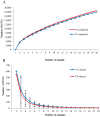Salivary Microbiome Diversity in Caries-Free and Caries-Affected Children
- PMID: 27898021
- PMCID: PMC5187778
- DOI: 10.3390/ijms17121978
Salivary Microbiome Diversity in Caries-Free and Caries-Affected Children
Abstract
Dental caries (tooth decay) is an infectious disease. Its etiology is not fully understood from the microbiological perspective. This study characterizes the diversity of microbial flora in the saliva of children with and without dental caries. Children (3-4 years old) with caries (n = 20) and without caries (n = 20) were recruited. Unstimulated saliva (2 mL) was collected from each child and the total microbial genomic DNA was extracted. DNA amplicons of the V3-V4 hypervariable region of the bacterial 16S rRNA gene were generated and subjected to Illumina Miseq sequencing. A total of 17 phyla, 26 classes, 40 orders, 80 families, 151 genera, and 310 bacterial species were represented in the saliva samples. There was no significant difference in the microbiome diversity between caries-affected and caries-free children (p > 0.05). The relative abundance of several species (Rothia dentocariosa, Actinomyces graevenitzii, Veillonella sp. oral taxon 780, Prevotella salivae, and Streptococcus mutans) was higher in the caries-affected group than in the caries-free group (p < 0.05). Fusobacterium periodonticum and Leptotrichia sp. oral clone FP036 were more abundant in caries-free children than in caries-affected children (p < 0.05). The salivary microbiome profiles of caries-free and caries-affected children were similar. Salivary counts of certain bacteria such as R. dentocariosa and F. periodonticum may be useful for screening/assessing children's risk of developing caries.
Keywords: 16S rRNA gene; children; early childhood caries; etiology; microbiome; saliva.
Conflict of interest statement
The authors declared no conflict of interest.
Figures







Similar articles
-
Comparison of the salivary and dentinal microbiome of children with severe-early childhood caries to the salivary microbiome of caries-free children.BMC Oral Health. 2019 Jan 14;19(1):13. doi: 10.1186/s12903-018-0693-1. BMC Oral Health. 2019. PMID: 30642327 Free PMC article.
-
Comparative analysis of salivary cytokine profiles and oral microbial composition in caries-active and caries-free children.J Dent. 2025 Mar;154:105611. doi: 10.1016/j.jdent.2025.105611. Epub 2025 Feb 5. J Dent. 2025. PMID: 39921084
-
Plaque bacterial microbiome diversity in children younger than 30 months with or without caries prior to eruption of second primary molars.PLoS One. 2014 Feb 28;9(2):e89269. doi: 10.1371/journal.pone.0089269. eCollection 2014. PLoS One. 2014. PMID: 24586647 Free PMC article.
-
[Significance of assessing risk factors for caries in their prevention].Orv Hetil. 2002 Jun 16;143(24):1467-73. Orv Hetil. 2002. PMID: 12138644 Review. Hungarian.
-
Salivary proteins and microbiota as biomarkers for early childhood caries risk assessment.Int J Oral Sci. 2017 Nov 10;9(11):e1. doi: 10.1038/ijos.2017.35. Int J Oral Sci. 2017. PMID: 29125139 Free PMC article. Review.
Cited by
-
HPV infection and bacterial microbiota in breast milk and infant oral mucosa.PLoS One. 2018 Nov 5;13(11):e0207016. doi: 10.1371/journal.pone.0207016. eCollection 2018. PLoS One. 2018. PMID: 30395655 Free PMC article.
-
Comparative Pan-Genome Analysis of Oral Veillonella Species.Microorganisms. 2021 Aug 20;9(8):1775. doi: 10.3390/microorganisms9081775. Microorganisms. 2021. PMID: 34442854 Free PMC article.
-
Saccharibacteria (TM7), but not other bacterial taxa, are associated with childhood caries regardless of age in a South China population.PeerJ. 2023 Jun 26;11:e15605. doi: 10.7717/peerj.15605. eCollection 2023. PeerJ. 2023. PMID: 37397017 Free PMC article.
-
Early Childhood Caries: Prevalence, Risk Factors, and Prevention.Front Pediatr. 2017 Jul 18;5:157. doi: 10.3389/fped.2017.00157. eCollection 2017. Front Pediatr. 2017. PMID: 28770188 Free PMC article. Review.
-
Cariogenic Microbiota and Emerging Antibacterial Materials to Combat Dental Caries: A Literature Review.Pathogens. 2025 Jan 23;14(2):111. doi: 10.3390/pathogens14020111. Pathogens. 2025. PMID: 40005488 Free PMC article. Review.
References
-
- World Health Organization Oral Health. 2012. [(accessed on 1 June 2016)]. Fact Sheet No 318. Available online: www.who.int/mediacentre/factsheets/fs318/en/index.htm.
-
- Marsh P.D. Microbial ecology of dental plaque and its significance in health and disease. Adv. Dent. Res. 1994;8:263–271. - PubMed
MeSH terms
Substances
LinkOut - more resources
Full Text Sources
Other Literature Sources
Medical

